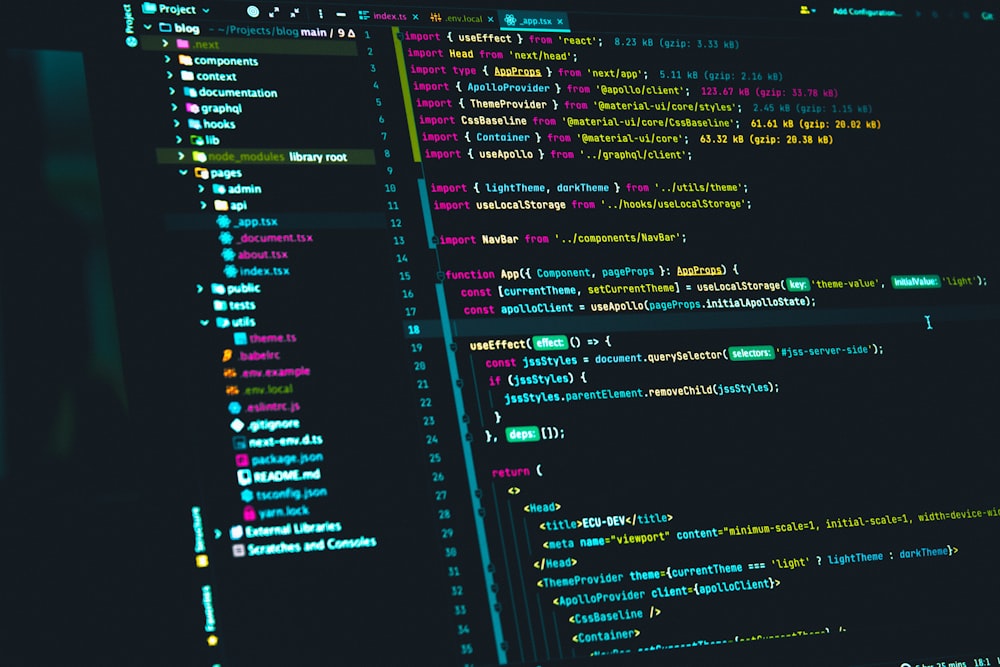5 reasons why Python sucks
Coding (Other languages)
Uncovering the Reasons Why Python Falls Short in Web Development

We all know how important web development is in today's digital world.
Python has certainly made its mark as a widely popular programming language.
But hey, let's have an honest conversation here.
You're going to dive into the limitations of Python when it comes to web development and explore some alternative languages that might just blow your mind!
If you're itching to learn more about the quirks and drawbacks of using Python for web development, you're in the right place.
You're here to shake things up and challenge the status quo.
And don't worry,
I've got some amazing alternatives that might just steal the show!
Performance Considerations
When it comes to performance, Python has its fair share of considerations for web development.
While Python is known for its simplicity and readability, it may not be the best choice for high-traffic or resource-intensive web applications.
One of the main factors affecting Python's performance is its execution speed compared to languages like Java, Go, or C++.
Python's interpreted nature can introduce some overhead, resulting in slower execution times.
This can become noticeable when dealing with computationally intensive tasks or real-time applications.
Additionally, Python's Global Interpreter Lock (GIL) can limit the potential for parallel execution, causing bottlenecks in multithreaded applications.
This can impact scalability and responsiveness in scenarios where high concurrency is required.
If you're building a smaller-scale application or focusing more on rapid development and maintainability, Python can still be a suitable choice.
For performance-critical web applications, it's worth exploring alternative languages like Java, Go, or C++.
These languages are often praised for their superior execution speeds and efficient memory management, making them ideal for handling high volumes of requests or resource-intensive tasks.
As always, it's crucial to analyze your project's specific needs and consider the trade-offs between development speed, maintainability, and performance.
There are also optimization techniques and tools available in the Python ecosystem that can help mitigate some performance concerns.
Asynchronous Programming
Asynchronous programming has become increasingly important in modern web development.
It allows developers to handle concurrent tasks efficiently.
Python offers asynchronous programming capabilities through libraries such as asyncio and frameworks like Tornado.
However, it's worth noting that Python's asynchronous capabilities come with some limitations.
Python's Global Interpreter Lock can still impact the performance of asynchronous code, limiting true parallelism even in an asynchronous context.
This means that Python may not be as efficient as languages explicitly designed for asynchronous web applications, such as Node.js or Go.
While libraries such as asyncio, aiohttp, and Tornado can be effective for certain use cases, they may not match the performance and scalability of languages more tailored to asynchronous programming.
Building highly scalable, event-driven systems with Python can present challenges due to the GIL and the need for careful resource management.
As the complexity of the application increases and the number of concurrent connections grows,
Python's limitations may become more pronounced.
If you anticipate building highly scalable, event-driven systems, languages like Node.js or Go might be more suitable choices.
Understanding your project's requirements and striking a balance between performance, scalability, and development ease will guide you toward the optimal choice for your web development endeavors.
Mobile Development
When it comes to mobile application development, Python may not be the first choice for many developers.
While Python offers versatility and ease of use, it has some limitations in the mobile development space.
One significant limitation is that Python is not a native language for mobile platforms like iOS and Android.
Native development languages such as Swift for iOS and Kotlin for Android provide better integration with the underlying platform, allowing developers to access platform-specific features and optimize performance.
The ecosystem and community support for mobile development are also stronger in languages like Swift and Kotlin.
These languages have dedicated frameworks and tools specifically designed for mobile app development.
For example, Swift has frameworks like SwiftUI and UIKit, while Kotlin offers the Android SDK and Jetpack libraries.
These frameworks provide robust capabilities and extensive documentation, making it easier for developers to build high-quality mobile applications.
Additionally, specialized tools like Xcode for iOS and Android Studio for Android provide comprehensive development environments tailored to their respective platforms.
These tools offer features like code completion, debugging, and profiling, which greatly facilitate mobile app development.
While Python does have frameworks like Kivy and BeeWare that allow cross-platform mobile development, they may not provide the same level of performance, native integration, and community support as Swift and Kotlin.
If you're considering mobile development, it's important to evaluate the specific requirements of your project.
If you're targeting a single platform, choosing the native language for that platform (Swift for iOS or Kotlin for Android) will likely result in a better user experience and a more efficient development process.
Specific Use Cases and Framework Limitations
While Python offers a variety of web frameworks that are widely used and appreciated, there are certain use cases where they may not be the best fit.
It's important to consider the specific requirements of your project and explore alternative frameworks or languages that excel in those areas.
One such use case is real-time applications that require instant updates and seamless bidirectional communication between the client and server.
Python web frameworks, being primarily request-response based, may not be the most suitable choice for these scenarios.
In such cases, you might consider using frameworks like Node.js with libraries such as Socket.io, which provide real-time capabilities and efficient event-driven communication.
Another consideration is high-performance APIs that need to handle a large volume of requests and respond quickly.
Python's interpreted nature and Global Interpreter Lock (GIL) can impose limitations on its performance in highly concurrent scenarios.
For building high-performance APIs, languages, like Go or frameworks like Node.js, Express.js, or Ruby on Rails (with the help of libraries like EventMachine or Celluloid), are often preferred due to their efficient concurrency models and ability to handle high loads.
There are also specialized frameworks available for specific web development requirements.
For example, if you're building a data-intensive web application, frameworks like Django or Flask might be suitable.
If you're focusing on microservices architecture, you could consider frameworks like FastAPI or Laravel (with the Lumen micro-framework).
For asynchronous web applications, languages like JavaScript with frameworks like Node.js or Deno provide excellent support for asynchronous programming, allowing developers to build scalable and efficient applications that can handle concurrent tasks seamlessly.
It's essential to assess the specific needs of your project and select the framework or language that aligns best with those requirements.
While Python web frameworks are powerful and versatile, exploring alternatives for specific use cases can lead to better performance, scalability, and developer productivity.
Python web frameworks have their strengths and are well-suited for a wide range of applications, yet, there are certain use cases where alternative frameworks or languages excel.
Real-time applications, high-performance APIs, and specific web development requirements may warrant exploring other options such as Node.js, Go, or specialized frameworks.
By selecting the right tools for the job, you can ensure optimal performance and productivity in your web development endeavors.
Community and Job Market Considerations
When considering a programming language for web development, it's important to take into account the community and job market considerations.
Python, undoubtedly, has a strong and supportive community, and it has gained significant popularity over the years.
However, it's worth exploring the demand for Python web developers in the job market and the availability of resources compared to alternative languages.
Python has a thriving job market globally, with numerous opportunities for web developers.
Many companies, ranging from startups to tech giants, utilize Python in their web development projects.
Python's versatility and wide range of applications make it a valuable skill to have.
However, it's important to note that the job market can vary based on geographical location and industry.
In some regions or industries, alternative languages might have a larger job market.
For example, JavaScript with frameworks like React or Angular has gained significant traction in the front-end web development space.
Similarly, languages like Java or C# have a well-established presence in enterprise web development.
Exploring the job market trends in your target region or industry can help you make an informed decision about which language aligns best with your career goals.
Community support is another crucial aspect to consider.
Python has a robust and supportive community that offers a wealth of resources, tutorials, and open-source libraries.
However, alternative languages may have larger and more diverse communities, providing extensive documentation, active forums, and a wider range of third-party libraries and frameworks.
The availability of resources and community support can greatly impact your learning journey and productivity as a web developer.
When choosing a programming language for web development, it's essential to balance the language's popularity, job market demand, and the availability of resources.
Consider your long-term career goals, the specific industry or region you're targeting, and the web development projects you aspire to work on.
Researching the job market trends, community support, and available resources can help you make an informed decision that aligns with your aspirations.
Ultimately, the choice of programming language for web development should be based on a combination of factors, including personal preference, project requirements, job market demand, and community support.
Evaluating these considerations will enable you to make a decision that not only meets your immediate needs but also sets you up for long-term success in the dynamic field of web development.
Conclusion
While Python has gained significant popularity as a programming language for web development, it does come with its limitations.
We've explored various aspects that make Python not the ideal choice in certain scenarios.
From performance considerations to mobile development and specialized use cases, there are instances where other languages shine brighter.
It's important to remember that choosing the right programming language for web development depends on specific project requirements.
Considering alternative languages like Swift, Kotlin, or JavaScript for specific domains can provide better solutions tailored to the task at hand.
So, if you're embarking on a new web development journey, don't be afraid to explore the vast landscape of programming languages.
Take into account the limitations and strengths of each language, and select the one that aligns best with your project goals.
Remember, the purpose of this blog post is to guide you in making informed decisions about the programming languages you choose.
There are plenty of resources and blog posts available to help you navigate the diverse world of web development.
So, keep exploring, experimenting, and learning.
The web development field is full of possibilities, and by exploring alternative languages, you might discover new avenues and innovative solutions that take your projects to the next level.
Stay curious and open-minded in your pursuit of becoming a proficient and adaptable web developer.
If you're interested in diving deeper into the world of programming languages, be sure to check out other blog posts on my website.
We're here to support your learning journey and provide guidance on various programming languages.

